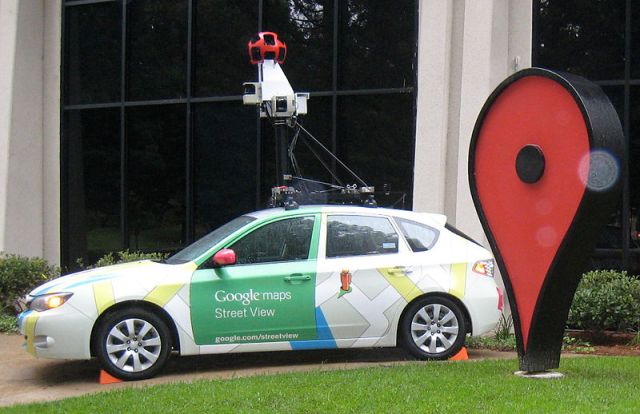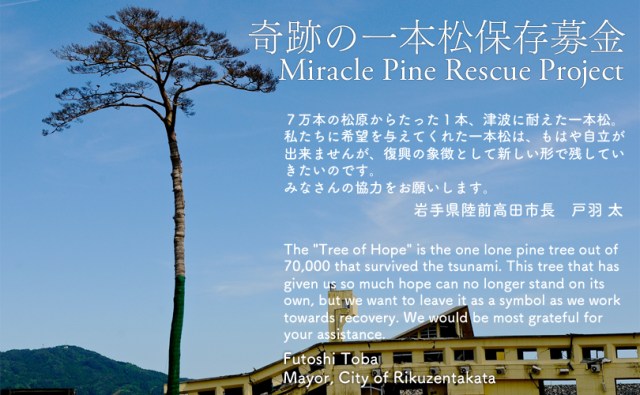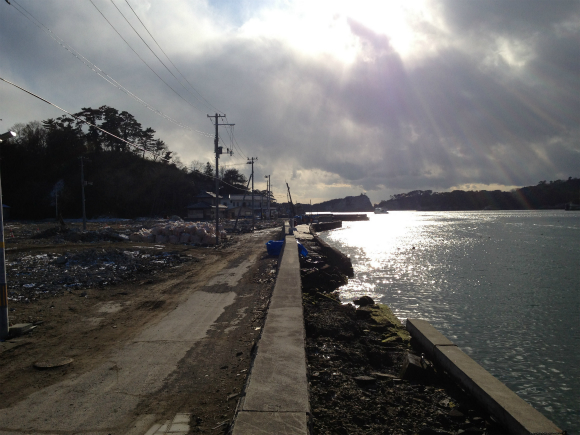Elementary and high school students from Miyagi Prefecture were given a special send off at Japan’s Narita Airport yesterday afternoon as they set off for the U.S. in order to convey messages of thanks for the efforts of those involved in relief operations following the 2011 earthquake and resulting tsunami in Northeast Japan.
tsunami (Page 3)
Following the most powerful earthquake ever to hit Japan, the sheer scale of the tsunami which smashed into northeastern Japan on March 11, 2011 was unprecedented. Coastal communities were devastated by waves which at their highest reached 40.5 meters above sea level, travelled up to 10km inland, and swept everything along with them. Mud, debris, cars, boats, houses, and fire.
The small town of Otsuchi in Iwate Prefecture was one of the hardest hit. About 10 percent of the population perished or went missing, including the mayor and many town officials. Iwate’s leading local newspaper, the Iwate Tokai Shimbun, was unable to continue operating as their printing press was washed out to sea, and two of their reporters were killed.
In 2012, a group of journalists banded together to once again start reporting the news from Otsuchi to support the town’s recovery, using the Internet to connect with people. Tsunami survivors have shared their stories of terror, panic, suffering and hope for the future through this new newspaper, known as the Otsuchi Mirai Shimbun (“Otsuchi Future Times”). These stories have been translated from the original Japanese into English by a team of 28 hard-working volunteers from Japan, Australia, New Zealand and the U.S., and published on the second anniversary of the disaster as a Kindle ebook.
Here are some excerpts from these true stories of survival:
The town of Rikuzentakata was once famous for its picturesque shoreline painted with 70,000 pine trees. However, when the ocean waters finally receded after the tsunami of March 11, 2011, only one tree remained. Standing proud at over 80 feet, this single pine battled on for 18 months after the tsunami until finally perishing due to the overwhelming amount of salt that was introduced to the surrounding earth. Although no longer standing tall, the memory of “the miracle pine” will live on thanks to a newly erected monument in its honor.
It wasn’t just the earthquake or tsunami of March 11, 2011 that shattered the town of Namie in Fukushima Prefecture, it was the subsequent radiation. Slowly creeping across the once fertile land, it ripped families from their homes and banished them to evacuation centers elsewhere. Today, nearly two years after the worse nuclear disaster since Chernobyl, the entire 86 square miles of Namie have been declared uninhabitable due to high levels of radioactive cesium. Even if families wanted to return, they can’t.
Amid this tragic loss, Google Street View is giving the people of Namie a chance to visit the town they were forced to flee.
Playstation 2 and Wii owners will likely be familiar with Ōkami, the adventure game set in ancient Japan that features an absolutely gorgeous wood-cut, cell-shaded graphic design.
The game puts players in control of the wolf incarnation of Shintō goddess Amaterasu, and quests them with using a magical, life-giving paintbrush to transform a dark, cursed world into one of plants, trees and flowers, as well as battling a few demons and evil spirits along the way.
On the same theme of restoration, a local website based in Rikuzentakata, a coastal town in Iwate prefecture severely damaged by the March 11 tsunami, has launched a special range of products officially backed by Capcom, the makers of Ōkami, with profits from their sale going to towards rebuilding the town and, much like the game, “restoring nature to its once beautiful state.”
The city of Rikuzentakata was thoroughly devastated by the March 11 tsunami. However, following the destruction a single 27 meter 200 year-old pine tree was left standing, the sole survivor of a forest of 70,000 trees along the coast line. The tree had become a symbol of hope for the country and local government vowed to protect it at all costs.
However, for the past year the tree’s health had been fading fast and it doesn’t have much longer to live. And so the city’s government is going to enact a preservation scheme which is rubbing Japanese netizens the wrong way due to its 150,000,000 yen (US$1.9M) price tag.
Needless to say, Japan has had their fill of Tsunamis. After the devastation of the 11 March Tohoku earth quake, the nation would like to give a huge FU to any future tsunami coming our way.
And so, three huge Japanese contractors are working on a special surprise for the next tsunami that tries to hit the shores of Wakayama prefecture in the form of a gigantic steel column. If successful it would be so poetically beautiful… if the Japanese only knew the beauty of the middle finger.
Text messages sent from Arisa Miura, a city worker who died in the tsunami that struck Minami-Sanriku in Miyagi Prefecture, and her boyfriend were released to the press on March 5th. In the 5 texts, which were sent between the two lovers after the earthquake and before Miura was swept away, one can see the depth of their affection in their consideration for the other’s safety even in a hectic emergency situation. Read More






 One of Japan’s most beautiful hot spring towns announces new limits on number of day trippers
One of Japan’s most beautiful hot spring towns announces new limits on number of day trippers Flying dango: Unique tourist site where Japanese sweets are flown to you over a gorge
Flying dango: Unique tourist site where Japanese sweets are flown to you over a gorge Cheeseburger rice bowls arrive at Japanese beef bowl chain Matsuya, and in our stomach【Taste test】
Cheeseburger rice bowls arrive at Japanese beef bowl chain Matsuya, and in our stomach【Taste test】 Do bears strike first with their left paw when attacking people? Japan wants to know
Do bears strike first with their left paw when attacking people? Japan wants to know History’s highest sumo wrestling and geisha dance to take place at Tokyo Skytree observation deck
History’s highest sumo wrestling and geisha dance to take place at Tokyo Skytree observation deck Domino’s Japan has all-you-can-eat pizza isn’t an Internet rumor, but it is hard to find
Domino’s Japan has all-you-can-eat pizza isn’t an Internet rumor, but it is hard to find Mario Kart Happy Meal toys arrive at McDonald’s Japan, and SoraNews24 has the whole set!【Photos】
Mario Kart Happy Meal toys arrive at McDonald’s Japan, and SoraNews24 has the whole set!【Photos】 American jackass tourist arrested after carving name into gate at Tokyo’s Meiji Shrine【Video】
American jackass tourist arrested after carving name into gate at Tokyo’s Meiji Shrine【Video】 Snuggle up to a Japanese Shiba Inu that looks real but is actually a cute hot water bottle cover
Snuggle up to a Japanese Shiba Inu that looks real but is actually a cute hot water bottle cover Beautiful park, gigantic wholesale market, and smooth-as-silk coffee on Omori bus loop【Tokyo Loop Buses】
Beautiful park, gigantic wholesale market, and smooth-as-silk coffee on Omori bus loop【Tokyo Loop Buses】 Ghibli’s Princess Mononoke teams up with Foxfire for outdoor apparel collaboration【Photos】
Ghibli’s Princess Mononoke teams up with Foxfire for outdoor apparel collaboration【Photos】 After cancelling Halloween, Tokyo’s Shibuya neighborhood cancels New Year’s Eve too
After cancelling Halloween, Tokyo’s Shibuya neighborhood cancels New Year’s Eve too Japanese job-quitting service contacted by other job-quitting service because employee wants to quit
Japanese job-quitting service contacted by other job-quitting service because employee wants to quit Sanrio and magical girl anime PreCure join forces for new merch line【Photos】
Sanrio and magical girl anime PreCure join forces for new merch line【Photos】 New Ghibli papercraft kit gives you a little Princess Mononoke forest on your desk【Photos】
New Ghibli papercraft kit gives you a little Princess Mononoke forest on your desk【Photos】 Beautiful Japanese garden green tea crepes waiting in Tokyo’s historical Asakusa neighborhood
Beautiful Japanese garden green tea crepes waiting in Tokyo’s historical Asakusa neighborhood Tokyo park’s sea of clouds, nighttime illumination, and cosplay days make now perfect time to visit
Tokyo park’s sea of clouds, nighttime illumination, and cosplay days make now perfect time to visit Samurai ritual suicide contest cancelled by organizer in west Japan
Samurai ritual suicide contest cancelled by organizer in west Japan Nintendo’s controller capsule toys are so cool, even the machine you buy them from is awesome【Pics】
Nintendo’s controller capsule toys are so cool, even the machine you buy them from is awesome【Pics】 Tokyo Disneyland loses top-attendance crown for Japanese theme parks for second year in a row
Tokyo Disneyland loses top-attendance crown for Japanese theme parks for second year in a row Ghibli Park debuts first winter illumination display with Howl’s Moving Castle theme
Ghibli Park debuts first winter illumination display with Howl’s Moving Castle theme Pringles releases a limited-edition sweet flavour in Japan
Pringles releases a limited-edition sweet flavour in Japan What’s the deal with akebi, the perfectly purple, alien-like fruit that’s in season now in Japan?
What’s the deal with akebi, the perfectly purple, alien-like fruit that’s in season now in Japan? McDonald’s new Happy Meals offer up cute and practical Sanrio lifestyle goods
McDonald’s new Happy Meals offer up cute and practical Sanrio lifestyle goods Foreign tourists on Shinkansen bullet train break suitcase etiquette, angering local passengers
Foreign tourists on Shinkansen bullet train break suitcase etiquette, angering local passengers [Deleted] Article written for April Fool’s Day 2018
[Deleted] Article written for April Fool’s Day 2018 Japanese government to make first change to romanization spelling rules since the 1950s
Japanese government to make first change to romanization spelling rules since the 1950s Foreigner’s request for help in Tokyo makes us sad for the state of society
Foreigner’s request for help in Tokyo makes us sad for the state of society Ghibli founders Toshio Suzuki and Hayao Miyazaki contribute to Japanese whisky Totoro label design
Ghibli founders Toshio Suzuki and Hayao Miyazaki contribute to Japanese whisky Totoro label design Japanese convenience store Family Mart announces abolishment of eat-in spaces
Japanese convenience store Family Mart announces abolishment of eat-in spaces Princesses, fruits, and blacksmiths: Study reveals the 30 most unusual family names in Japan
Princesses, fruits, and blacksmiths: Study reveals the 30 most unusual family names in Japan Life-size vibrating Legend of Zelda Master Sword for sale from Nintendo【Photos】
Life-size vibrating Legend of Zelda Master Sword for sale from Nintendo【Photos】 Studio Ghibli releases free-download board game — Here’s how to play it without reading Japanese
Studio Ghibli releases free-download board game — Here’s how to play it without reading Japanese Domino’s Japan has all-you-can-eat pizza isn’t an Internet rumor, but it is hard to find
Domino’s Japan has all-you-can-eat pizza isn’t an Internet rumor, but it is hard to find Mario Kart Happy Meal toys arrive at McDonald’s Japan, and SoraNews24 has the whole set!【Photos】
Mario Kart Happy Meal toys arrive at McDonald’s Japan, and SoraNews24 has the whole set!【Photos】 American jackass tourist arrested after carving name into gate at Tokyo’s Meiji Shrine【Video】
American jackass tourist arrested after carving name into gate at Tokyo’s Meiji Shrine【Video】 Snuggle up to a Japanese Shiba Inu that looks real but is actually a cute hot water bottle cover
Snuggle up to a Japanese Shiba Inu that looks real but is actually a cute hot water bottle cover Beautiful park, gigantic wholesale market, and smooth-as-silk coffee on Omori bus loop【Tokyo Loop Buses】
Beautiful park, gigantic wholesale market, and smooth-as-silk coffee on Omori bus loop【Tokyo Loop Buses】 The Japan Poop Society is making movements to protect people’s health
The Japan Poop Society is making movements to protect people’s health Haunted hospital near Mt Fuji re-opens after renovation at Fuji-Q Highland, and it’s terrifying
Haunted hospital near Mt Fuji re-opens after renovation at Fuji-Q Highland, and it’s terrifying When is the right time for a love confession in Japan?
When is the right time for a love confession in Japan? Fukushima man arrested for defecating on another person’s bicycle seat
Fukushima man arrested for defecating on another person’s bicycle seat Are you faster than a 90-year-old? Japan’s Turbo Granny still smashing records
Are you faster than a 90-year-old? Japan’s Turbo Granny still smashing records What’s the most popular way to prepare Japan’s beloved breakfast dish, Tamago Kake Gohan?
What’s the most popular way to prepare Japan’s beloved breakfast dish, Tamago Kake Gohan?